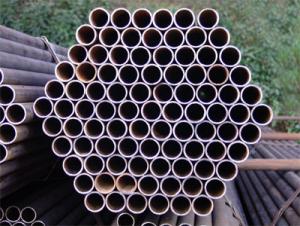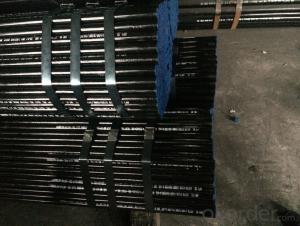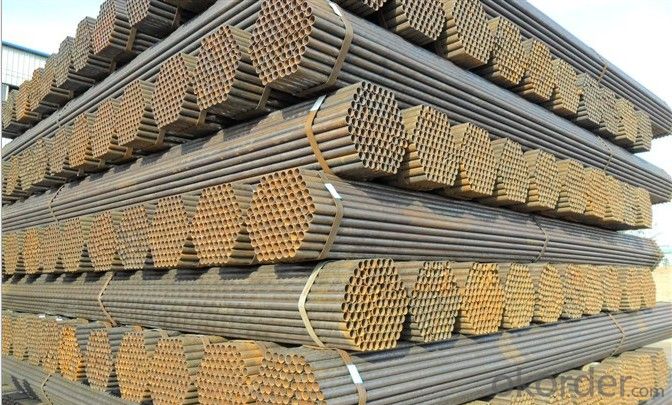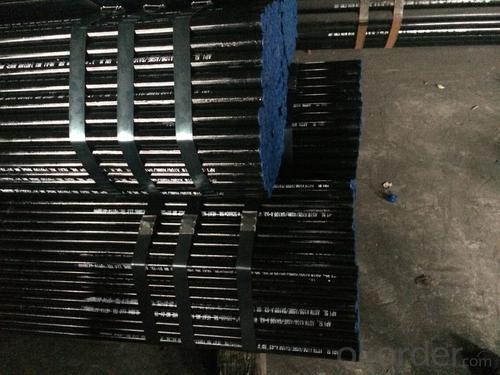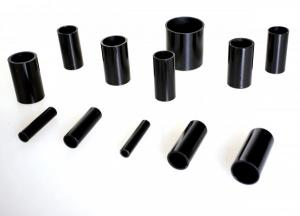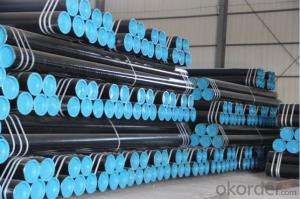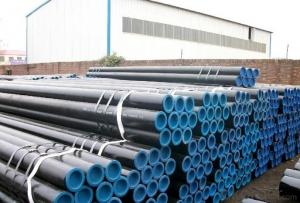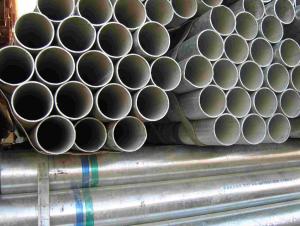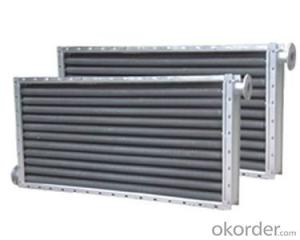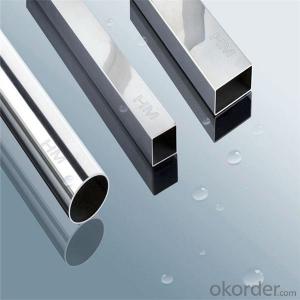Boiler, Heat Exchanger, Condenser, Pressure VesselTube
- Loading Port:
- Shanghai
- Payment Terms:
- TT or LC
- Min Order Qty:
- 25 m.t.
- Supply Capability:
- 6500T m.t./month
OKorder Service Pledge
OKorder Financial Service
You Might Also Like
1、Structure of Seamless ASTM A500 A53 American Standard Steel Pipe/Tube :
Seamless ASTM A500 A53 American Standard Steel Pipe/Tube is to be used for conveying gas, water, and petroleum foroil and natural gas industries. And used for structural steel pies purpose. As the manufacturing process does not include any welding, seamless pipes are perceived to be stronger and more reliable. Historically seamless pipe was regarded as withstanding pressure better than other types, and was often more easily available than welded pipe.
2、Main Features of Seamless ASTM A500 A53 American Standard Steel Pipe/Tube :
• High manufacturing accuracy
• High strength
• Small inertia resistance
• Strong heat dissipation ability
• Good visual effect
• Reasonable price
3、Seamless ASTM A500 A53 American Standard Steel Pipe/Tube ,Specification:
Standard | GB, DIN, ASTM ASTM A106-2006, ASTM SPEC 5CT-2007 |
Grade | 10#-45#, 16Mn 10#, 20#, 45#, 16Mn |
Thickness | 8 - 33 mm |
Section Shape | Round |
Outer Diameter | 133 - 219 mm |
Place of Origin | Shandong, China (Mainland) |
Secondary Or Not | Non-secondary |
Application | Hydraulic Pipe |
Technique | Cold Drawn |
Certification | API |
Surface Treatment | factory state or painted black |
Special Pipe | API Pipe |
Alloy Or Not | Non-alloy |
Length | 5-12M |
Outer Diameter | 21.3-610mm |
Grade | 20#, 45#, Q345, API J55, API K55, API L80, API N80, API P110, A53B |
Standard | ASME, ASTM |
1) Material:20#(ASTM A 106/A53 GRB.API5LGRB,GB),45#,16Mn,10#.
2) Specification range:OD:21.3-610mm,WT:6-70mm,length:6-12m or according to the requirement of clients.
3) Excutive standards:GB,ASME API5L.ASTM A 106/A53,Despite of the above standards,we can also supply seamless steel pipe with standard of DIN,JIS,and so on,and also develop new products according to the requirements of our clients!
4) Surface:black lacquered,varnish coating or galvanized.
5) Ends:Beveled or square cut,plastic capped,painted.
6) Packing:bundles wrapped with strong steel strip,seaworthy packing.
4、Packaging & Delivery
Packaging Details: | seaworthy package,bundles wrapped with strong steel strip |
Delivery Detail: | 15-30days after received 30%TT |
5、FAQ of Seamless ASTM A500 A53 American Standard Steel Pipe/Tube :
①How is the quality of your products?
Our products are manufactured strictly according to national and internaional standard, and we take a test
on every pipe before delivered out. If you want see our quality certifications and all kinds of testing report, please just ask us for it.
Guaranteed: If products’ quality don’t accord to discription as we give or the promise before you place order, we promise 100% refund.
②How about price?
Yes, we are factory and be able to give you lowest price below market one, and we have a policy that “ for saving time and absolutely honest business attitude, we quote as lowest as possible for any customer, and discount can be given according to quantity”,if you like bargain and factory price is not low enough as you think, just don’t waste your time.Please trust the quotation we would give you, it is professional one.
③Why should you chose us?
Chose happens because of quality, then price, We can give you both.Additionally, we can also offer professional products inquiry, products knowledge train(for agents), smooth goods delivery, exellent customer solution proposals.Our service formula: good quality+good price+good service=customer’s trust
SGS test is available, customer inspection before shipping is welcome, third party inspection is no problem.
6、 Seamless ASTM A500 A53 American Standard Steel Pipe/Tube : Images:
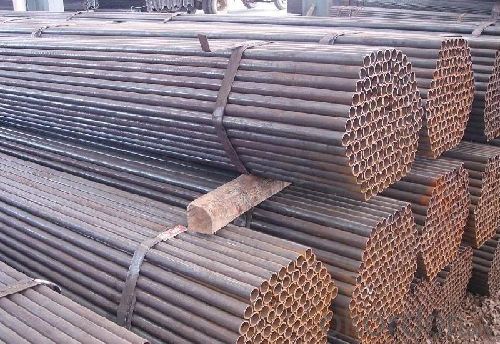
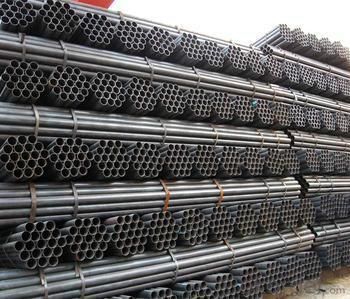
- Q: What is the difference between steel pipes and PPR pipes?
- Steel pipes are made of steel and are primarily used for transporting liquids and gases in industries such as oil, gas, and construction. They are durable, resistant to high temperatures and pressure, and have a long lifespan. On the other hand, PPR (polypropylene random copolymer) pipes are made of plastic and are commonly used for plumbing systems in residential and commercial buildings. PPR pipes are lightweight, easy to install, corrosion-resistant, and have good thermal insulation properties. They are more suitable for carrying water and other non-corrosive fluids.
- Q: Can steel pipes be used for underground sewage systems?
- Yes, steel pipes can be used for underground sewage systems. Steel pipes are known for their durability and strength, making them suitable for underground applications. However, it is essential to ensure that the steel pipes are properly coated or protected against corrosion to prevent damage from sewage and soil conditions.
- Q: Can steel pipes be used for underground oil and gas pipelines?
- Yes, steel pipes can be used for underground oil and gas pipelines. Steel is a widely used material in the oil and gas industry due to its strength, durability, and resistance to corrosion. Steel pipes are capable of withstanding the high pressure and extreme conditions often encountered in underground pipelines, making them a reliable choice for transporting oil and gas.
- Q: How do you calculate the pipe flow rate for steel pipes?
- In order to calculate the flow rate of steel pipes, one must take into account various factors. Initially, the inside diameter of the pipe, which is commonly represented as D, needs to be determined. Subsequently, the length of the pipe, denoted as L, should be measured. Furthermore, one must be aware of the pressure drop, ΔP, across the pipe and the density of the fluid, ρ. Once all this information is obtained, either the Darcy-Weisbach equation or the Hazen-Williams equation can be utilized to calculate the flow rate. The Darcy-Weisbach equation is typically employed for pipes with turbulent flow, whereas the Hazen-Williams equation is commonly used for pipes with laminar flow. For the Darcy-Weisbach equation, the formula is as follows: Q = (π/4) * D^2 * √(2ΔP/ρ) Here, Q denotes the flow rate in cubic meters per second, D represents the inside diameter of the pipe in meters, ΔP signifies the pressure drop across the pipe in pascals, and ρ stands for the fluid density in kilograms per cubic meter. On the other hand, for the Hazen-Williams equation, the formula is as follows: Q = C * (D^2.63) * (ΔP^0.54) * (L^0.63) In this case, Q represents the flow rate in cubic meters per second, D denotes the inside diameter of the pipe in meters, ΔP signifies the pressure drop across the pipe in pascals, L represents the length of the pipe in meters, and C represents the Hazen-Williams coefficient, which relies on the roughness of the pipe. To ensure an accurate calculation of the pipe flow rate, it is imperative to maintain consistent units of measurement throughout the calculation. Additionally, precise measurements of the inside diameter, length, pressure drop, and fluid density are crucial in obtaining reliable results.
- Q: Are there specifications for scaffold steel pipe with 48mm * 3.2mm?
- However, there are a variety of non GB steel tubes on the market, mainly in the wall thickness, and are thinner than the national standard requirements, you said that thickness may have, but the thinnest only about 2.6mm-2.7mm.
- Q: What are the factors affecting the durability of steel pipes?
- The factors affecting the durability of steel pipes include corrosion, temperature, pressure, mechanical stress, and the quality of the protective coatings or linings applied to the pipes. Additionally, the composition and purity of the steel used in the pipes, as well as the design and construction of the pipeline system, can also impact its durability.
- Q: How are steel pipes classified based on pressure ratings?
- Steel pipes are classified based on pressure ratings into different categories such as schedule numbers or pressure classes, which indicate their ability to withstand different levels of pressure.
- Q: How are steel pipes used in the telecommunications infrastructure industry?
- Steel pipes are used in the telecommunications infrastructure industry to provide a strong and durable framework for the installation of fiber optic cables, conduits, and other communication equipment. They are used for underground cable routing, overhead cable support, and the construction of telecommunication towers, ensuring reliable and efficient communication networks.
- Q: How are steel pipes repaired if they are damaged?
- Steel pipes can be repaired if they are damaged through various methods such as welding, patching, or using pipe clamps.
- Q: How are steel pipes used in the manufacturing of power distribution systems?
- Steel pipes are commonly used in the manufacturing of power distribution systems as they provide a reliable and durable solution for transporting and protecting electrical cables. They are used to create conduits that house the cables, ensuring safe and efficient transmission of electricity throughout the system. Steel pipes also offer resistance to corrosion, fire, and extreme weather conditions, making them a suitable choice for power distribution systems.
Send your message to us
Boiler, Heat Exchanger, Condenser, Pressure VesselTube
- Loading Port:
- Shanghai
- Payment Terms:
- TT or LC
- Min Order Qty:
- 25 m.t.
- Supply Capability:
- 6500T m.t./month
OKorder Service Pledge
OKorder Financial Service
Similar products
Hot products
Hot Searches
Related keywords
